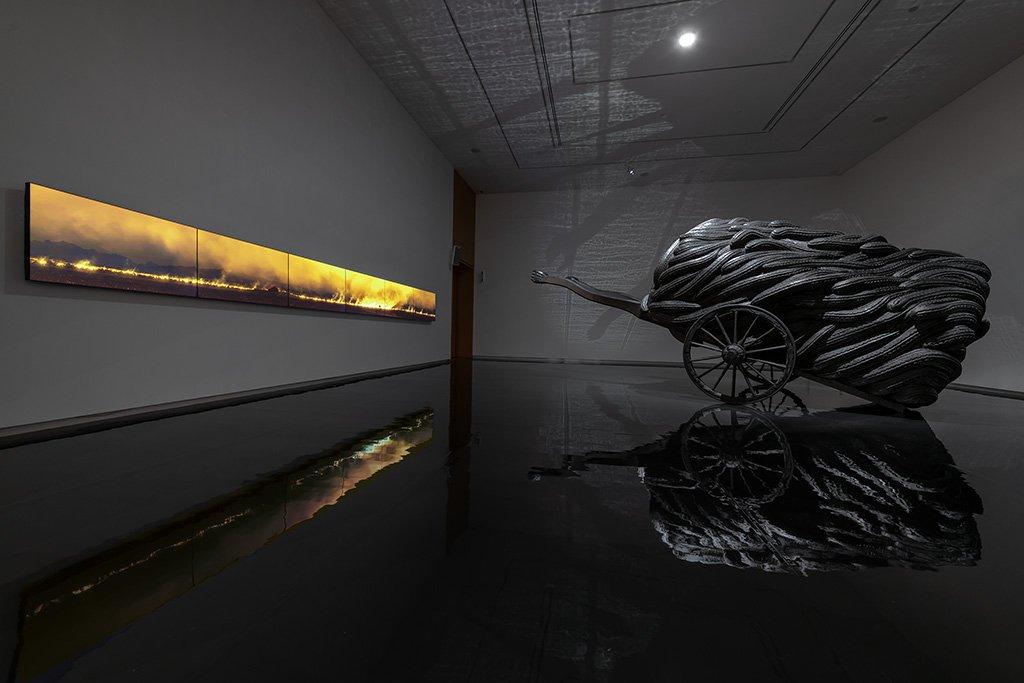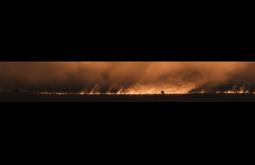Brett Graham's exhibition Wastelands opened at Auckland Art Gallery Toi o Tāmaki in June 2025. Featuring a monumental sculpture of the same name that was commissioned for the 60th Venice Biennale in 2024, the haunting installation is expanded to include a new multi-channel video work, titled Whangamārino (2025). Re-working footage shot by news company Aukaha of a 2024 fire in the Whangamārino wetlands, Graham's new work adds layers of animation, personal history, and an ominous soundtrack.
The resulting installation addresses both the history of colonial exploitation and our contemporary ecological crisis. Over 1.2 million acres of Waikato-Tainui land were confiscated by the colonial government following the Waste Lands Act (1858), the Waikato War (1863–64), and the New Zealand Settlements Act (1863), with devastating consequences for tangata whenua and te taio. In this exhibition, Graham powerfully addresses the resulting degradation of the Waikato River and its surrounding wetlands, a precious resource and taonga for his iwi.
In this kōrero with Kathryn Graham, Brett discusses Wastelands, his earlier work Tai Moana Tai Tangata (2020), and presenting Wastelands at the Venice Biennale in 2024.
This podcast was conceived and hosted by Kathryn Graham (Ngāti Koroki Kahukura).
List of topics
00:00: Introduction by Kathryn Graham
01:00: Kathryn asks, what will the installation at Auckland Art Gallery Toi o Tāmaki look like?
01:50: What exactly are the 'Wastelands' referred to in the work? Brett discusses a piece of colonial era legislation, the Waste Lands Act (1858) which gave ownership of all "uncultivated" land to settlers.
03:00: Brett: "There’s a phobia in the settler mind of the idea of a swamp or being encompassed by black water that I was playing on..." The value of the wetland to Māori as a source of food.
04:00: On the sculpture Wastelands (2024), and how Māori could live and hide in the wetlands during the land wars; the clearing of the land was about "making it safe for them (Pākeha) ... in the same way as they're clearing out Gaza now."
05:00: The peat swamp as a palimpsest, as layers of whakapapa, history, and land.
06:00: On reworking the original video footage shot by news company Aukaha, with Sam Tozer and his production company with Nat Tozer, LOT23.
07:00: On Māori burying tāonga in the swamps, as a metaphor for history being lost.
08:00: Brett recalls watching LOT23 work.
08:45: Discussion of the audio soundtrack by Daniel Campbell-MacDonald, and Brett’s preference for non-literal audio interpretations of the imagery, and it the foreboding quality.
09:45: Brett and Kathryn discuss Brett's 2020 exhibition at the Govett-Brewster, Tai Moana Tai Tangata, which featured a series of sculptures alongside a multi-channel landscape video. On choosing Taranaki and Te Tai Hauāuru as a subject for Tai Moana Tai Tangata: "So many of our stories begin in some village on the East Coast … on the West Coast, most of the land was confiscated so those Waikato and Taranaki stories don’t enter the national narrative … I felt the West Coast had been neglected … that’s why the emphasis is on Te Tai Hauāuru." He discusses the coastline locations featured in the work (Ohawe, Te Namu).
11:00: On the ecological and historical themes in the work: the eruption of Taranaki Maunga in 1854, the mining of black sand, the sinking of the steamer Worsley, and Te Ua Haumēne's visions of the angel Gabriel, which led to the creation of Te Pai Mārire.
12:00: On working with the company Animation Research. The soundtrack is by sound artist Daniel Campbell-MacDonald, "which is quite haunting."
12:40: Brett describes reading letters written by early settlers in the 1840s, when they were dependent on Māori to feed them; he describes their assumption of superiority to tangata whenua, and that all the land around them would be theirs; their fascination with with iron sands: "they monetised everything ... had freedoms unavailable in England, could never dream of owning property or setting up businesses, a bit like if we landed on Mars, we’d rob it blind for all its resources."
14:20: Brett discusses augmenting the drone footage shot for Tai Moana Tai Tangata: “I’ve taken [this] to its extreme by adding oil derricks and oil flares ... by talking about how the current logic of extraction has led to the current crisis of climate change." He attributes the source of the title to a proverb by Te Rauparaha to Te Wherowhero: "Ka pari te tai moana, ka timu te tai tangata," "When the ocean tide rises, the human tide recedes."
15:00: On working on the video over the pandemic: "I had a long time to think about it."
16:00: More on working with Animation Research and Brett’s intention for the images.
17:00: Kathryn asks, which film goes with which sculpture? Brett discusses the works installed in the idiosyncratic spaces of the Govett-Brewster Art Gallery, which is a former movie theatre. Brett talks about the "ambiguous language" of the sculptures: are they "symbols of hope and welcome for the settlers, or witnesses of doom as more settlers encroached on the land?"
18:50: Kathryn: "Why incorporate film alongside the sculptures?" Brett: "I wanted to introduce that element of narrative that you can do in film that you cannot necessarily do with sculpture."
19:30: Brett on the process of working with Daniel Campbell-MacDonald—"I gave him a lot of freedom." Kathryn: "I remember [the soundtrack] felt very oppressive." Brett: "The bass goes right through your nervous system … that’s what I wanted to create … literally sending vibrations through the body."
21:00: Kathryn asks, what does it mean to present work from a Māori context in international forums like Venice? Brett discusses his first visit to Venice in 2007 to show his collaborative work with Rachael Rakena (Ngai Tahu, Nga Puhi), Āniwaniwa (2007), and the communication of the broad theme of cultural loss through drowning. Brett discusses showing Wastelands in Venice in 2024, and the effect of the work being surrounded by other Indigenous artists, including his father Fred Graham’s work, which were "… all referring to nature and what happens man harnesses the power of nature and then abuses it."
23:30: Brett discusses the Venice Biennale theme of 'Foreigners Everywhere': "…to the point where Māori have been marginalised as foreigners in their own land … all of the things taken as normal in this country were imposed upon us … all our government institutions are based on Westminster."
24:30: Kathryn asks, what was the reaction of people in the space?
25:30 Kathryn: "How important is it to show your work at the Venice Biennale?" Brett: "Do we need validation from Europeans? I think those kind of exchanges are so valuable … for them to understand matauranga Māori beyond the haka is priceless … they don’t really have a great sense of Indigeneity in Europe, they’re quite backwards in how the view Indigenous people." He discusses the rising prominence of Indigenous artists at Venice: "It’s really putting those issues to the fore."


-circuit.jpg)
,-part-of-the-wastelands-(2024).-installation-view,-auckland-art-gallery-toi-o-tamaki,-2025.-image-courtesy-of-the-artist.jpg)